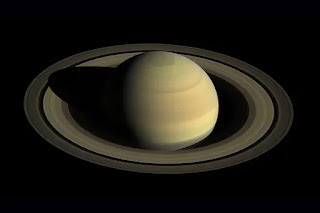Saturn is the sixth planet from the sun and the second-largest planet in the solar system. It's the farthest planet from Earth that's visible to the naked human eye, but the planet's most outstanding features its rings are better viewed through a telescope. Although the other gas giants in the solar system Jupiter, Uranus and Neptune also have rings, Saturn's rings are particularly prominent, earning it the nickname the "Ringed Planet."
Physical Characteristics Of Saturn
Saturn is a gas giant made up mostly of hydrogen and helium. Saturn's volume is greater
than 760 Earths, and it is the second most massive planet in the solar system, about 95 times Earth's mass. The Ringed Planet is the least dense of all the planets, and is the only one less dense than water. If there were a bathtub big enough to hold it, Saturn would float.
The yellow and gold bands seen in Saturn's atmosphere are the result of superfast winds in the upper atmosphere, which can reach up to 1,100 mph (1,800 km/h) around its equator, combined with heat rising from the planet's interior. Saturn rotates about once every 10.5 hours. The planet's high-speed spin causes Saturn to bulge at its equator and flatten at its poles. The planet is around 75,000 miles (120,000 kilometers) across at its equator, and 68,000 miles (109,000 km) from pole to pole.
Saturn' Rings
Galileo Galilei was the first to see Saturn's rings in 1610, although from his telescope the rings looked more like handles or arms. Forty five years later, in 1655, Dutch astronomer Christiaan Huygens, who had a more powerful telescope, later proposed that Saturn had a thin, flat ring.
Saturn's Moons
Saturn has at least 62 moons. The largest, Titan, is slightly larger than Mercury, and is the second-largest moon in the solar system behind Jupiter's moon Ganymede (Earth's moon is the fifth largest).
Some of the moons have extreme features. Pan and Atlas are shaped like flying
saucers; Iapetus has one side as bright as snow and one side as dark as coal. Enceladus shows evidence of "ice volcanism": a hidden ocean spews out water and other chemicals from the 101 geysers spotted at the moon's southern pole. A number of these satellites, such as Prometheus and Pandora, are referred to as shepherd moons because they interact with ring material and keep the rings in their orbits.
Though scientists have identified many moons, Saturn has other small moons constantly being created and destroyed.
Additional Resources:-








No comments:
Post a Comment